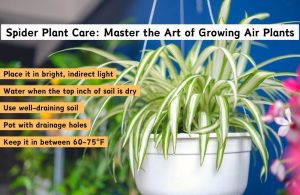This article covers the following areas –
- Unfolding the Natural Habitat of the Parlor Palm
- Getting the Light Just Right: Key to Parlor Palm Care
- Watering and Humidity Needs
- Feeding Your Parlor Palm
- Housing Your Parlor Palm: Potting and Repotting
- Grooming Your Parlor Palm: Pruning and Cleaning
- Troubleshooting Common Problems: Understanding Parlor Palm Symptoms
- In Conclusion
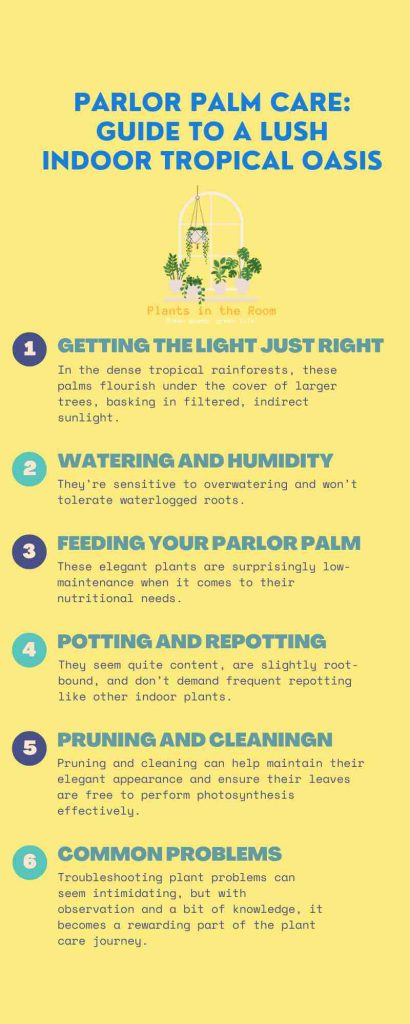
When I first introduced a Parlor Palm into my indoor garden, I was immediately captivated by its delicate, feathery fronds and compact growth. Through hands-on experience and trial and error, I’ve learned that Parlor Palms, despite their tropical roots, are quite straightforward to care for. In this comprehensive guide, I will delve into all aspects of Parlor Palm care, from light requirements and watering routines to potting practices and troubleshooting common problems.
Parlor Palm care involves mimicking its natural rainforest habitat. Provide dappled light, consistently moist soil, high humidity, and feed with diluted fertilizer during the growing season. Avoid overwatering, over-fertilizing, and repot sparingly, as Parlor Palms prefer being root-bound.
Continue reading this comprehensive guide to learn more about Parlor Palm care, including its specific light, watering, feeding, potting, and repotting needs. This guide also provides practical advice on pruning your Parlor Palm and troubleshooting common problems to ensure your plant remains vibrant and healthy.
Unfolding the Natural Habitat of the Parlor Palm

Before setting off on our journey to establish a flourishing indoor tropical oasis, I find understanding the Parlor Palm’s natural habitat indispensable. Parlor Palms, also known as Chamaedorea elegans, are understory plants hailing from the dense, moist rainforests of Central and South America.
In their native settings, they thrive beneath the thick canopy, relishing in the dappled sunlight and high humidity. Getting to grips with these conditions has been the cornerstone of my approach to Parlor Palm care, enabling me to replicate these conditions within my home and cultivate a thriving Parlor Palm indoors.
An Understory Plant
Parlor Palms are understory plants, which means they are accustomed to the lower light levels found on the rainforest floor. Their inherent ability to prosper beneath the dense overhead canopy significantly impacts their indoor care.
Light Preferences
Understory plants like the Parlor Palm are used to dapple filtered sunlight, a vital factor that shaped my approach to its lighting requirements. This understanding has led me to place my Parlor Palm in spots that receive moderate, indirect light, such as near a north-facing window or a few feet away from an east-facing window. I always shield it from harsh direct sunlight that can scorch its delicate fronds.
Humidity Preferences
The high humidity is another crucial aspect of the Parlor Palm’s understory existence. The rainforest environment is naturally humid, so Parlor Palms adore moisture. To replicate this at home, I’ve adopted a routine of regular misting or occasionally placing the pot on a tray filled with pebbles and water. This increases the humidity around the plant and replicates a sense of its native tropics.
| Environment | Parlor Palm Adaptation | Home Care Replication |
|---|---|---|
| Rainforest Understory | Prefers indirect, dappled light | Regularly mist the plant; place the pot on a pebble tray filled with water to increase ambient humidity. |
| Rainforest Humidity | Loves high moisture levels | Regularly mist the plant; place the pot on a pebble tray filled with water to increase ambient humidity |
Getting the Light Just Right: Key to Parlor Palm Care
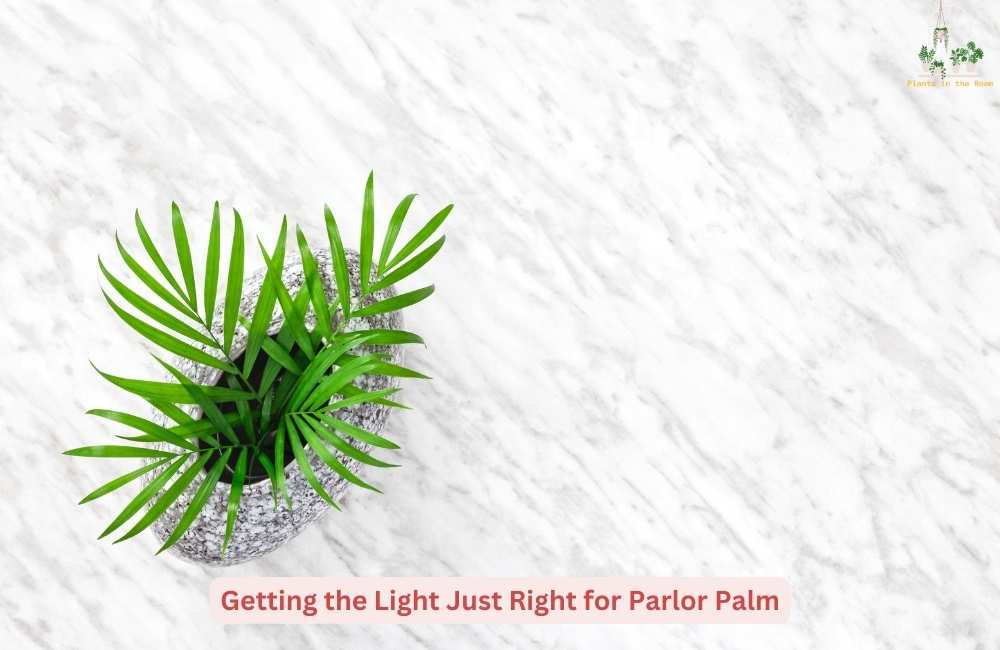
A crucial part of my journey with Parlor Palms involved understanding their light requirements. In the dense tropical rainforests, these palms flourish under the cover of larger trees, basking in filtered, indirect sunlight. It’s no surprise that they carry this preference into our homes.
When I first brought home a Parlor Palm, I mistakenly positioned it in a spot that received direct sunlight. I quickly noticed a worrying yellowing of the leaves, a clear sign of distress. From that day on, I was careful to provide the conditions it preferred – indirect, dappled light. My favorite spots for placing my Parlor Palms have since been near north or east-facing windows, where they receive gentle, indirect sunlight throughout the day.
The Consequences of Too Much Light
Learning from my initial misstep, I realized these understory plants are not built to tolerate harsh, direct sunlight. In the wild, they are shielded from the sun’s direct rays by a thick overhead canopy. Exposing your Parlor Palm to direct sunlight in your home can result in the scorching of the fronds, leading to a yellow or brown discoloration and potentially harming the plant’s overall health.
Signs Your Parlor Palm Is Not Receiving Adequate Light
While avoiding direct sunlight is critical, ensuring your Parlor Palm gets enough light to thrive is also important. If placed in a location that’s too dim, the plant’s growth may be stunted, and its vibrant green color may fade. I found this balance through trial and error, shifting my plant around until it appeared most content.
Understanding the light needs of your Parlor Palm and adjusting its position to suit these requirements can ensure it stays healthy and vibrant, mirroring the lushness of its natural habitat. I found this an essential aspect of successful Parlor Palm care.
Watering and Humidity Needs
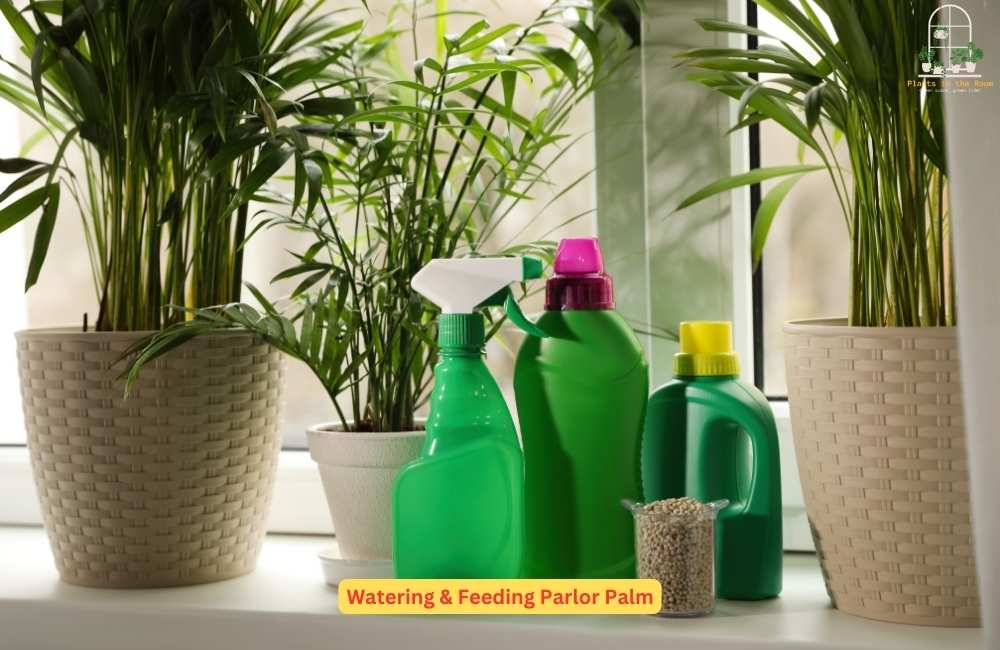
Among the initial challenges I faced while caring for my Parlor Palm was getting the watering schedule right. I learned that these tropical natives prefer their soil to be consistently moist, reflecting their rainforest origins. However, they’re sensitive to overwatering and won’t tolerate waterlogged roots.
Striking the Right Watering Balance
It took a bit of trial and error, but I eventually found the ideal watering routine for my Parlor Palm. I water the plant thoroughly until some water drains out from the bottom. Then, I wait until the top inch of the soil dries out before the next watering. This approach ensures the plant receives enough water without the risk of root rot, a common problem with overwatering.
Mimicking Rainforest Humidity
One of the defining characteristics of a Parlor Palm’s natural habitat is the high humidity. To emulate this in an indoor environment, I use two main methods. Firstly, I regularly mist my Parlor palms, especially during dry winter. The droplets on the fronds create a humid microclimate around the plant that mimics the moisture-laden air of the tropics.
Secondly, I place the plant pot on a tray filled with pebbles and water. The idea behind this is that the water in the tray slowly evaporates, increasing the humidity around the plant. Since I started using this method, I have noticed a significant improvement in the vitality of my Parlor Palm, with greener leaves and more vigorous growth.
Proper watering and maintaining humidity are crucial in Parlor Palm care. By mimicking the conditions of the rainforest, we can help these beautiful palms to thrive indoors.
Feeding Your Parlor Palm
Fertilizing my Parlor Palm was a task that required a bit of fine-tuning. These elegant plants are surprisingly low-maintenance when it comes to their nutritional needs. They are not voracious eaters; as I discovered the hard way, they can be quite sensitive to over-fertilization. Too much fertilizer can lead to chemical burns, affecting the root system and overall plant health.
Choosing the Right Fertilizer
After experimentation, I settled on a balanced houseplant fertilizer for my Parlor Palm. I use this at a diluted strength – about half of what’s recommended on the fertilizer package. This seems to be the sweet spot that provides my Parlor Palm with the nutrients it needs without overwhelming it.
Timing the Feedings
Another aspect I discovered was the importance of timing when feeding the Parlor Palm. These palms go through a growing season, typically from spring to summer, when their nutritional needs increase. During this time, I feed my palm once a month with diluted fertilizer. Come winter, I stop the feeding as the plant goes into a sort of dormancy and doesn’t require additional nutrients.
Pre-Watering: A Crucial Step
One essential step I never skip is watering my Parlor Palm before feeding it. This simple act goes a long way in protecting the plant’s roots from potential fertilizer burns. The water creates a buffer between the roots and the fertilizer, preventing the concentration of nutrients from causing any harm.
All these small but significant steps have helped me ensure my Parlor Palm receives just the right amount of nutrition. With careful feeding, these resilient palms can stay healthy and vibrant, adding a lush, tropical touch to your indoor space.
Housing Your Parlor Palm: Potting and Repotting
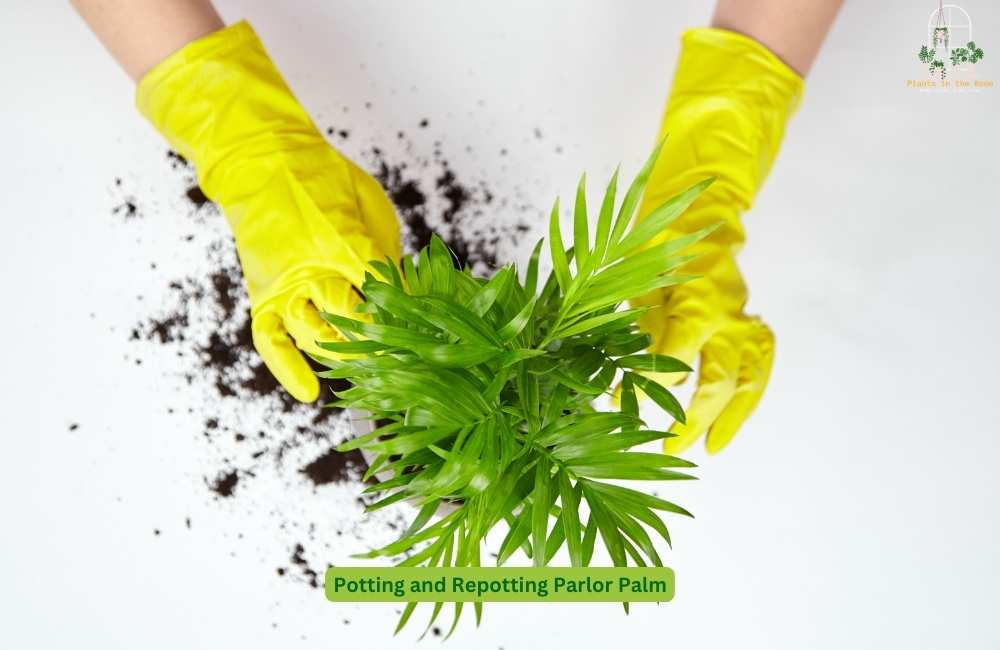
In my journey of nurturing a Parlor Palm, I’ve learned that they are relatively low-maintenance when it comes to their housing needs. They seem quite content, are slightly root-bound, and don’t demand frequent repotting like other indoor plants. However, ensuring they have the right pot and soil can significantly affect their overall health and growth.
Choosing the Right Pot
Parlor Palms, with their feathery, arching fronds, can grow to quite a height, making it necessary to select a sturdy pot that can balance their top-heavy nature. I usually go for a pot that’s one size larger than its current one when it’s time to repot. Equally important is the presence of drainage holes in the pot. Parlor Palms are susceptible to root rot if left in standing water, so good drainage is vital.
The Best Soil for Parlor Palms
When it comes to the potting mix, well-draining soil is the name of the game. I use a standard houseplant mix and perlite or sand to improve drainage. This mixture seems to do the trick, providing the right water retention and drainage balance.
Timing and Signs for Repotting
Repotting my Parlor Palm is not a frequent task, typically needed only every two years or so. However, watching for signs that your palm may be ready for a new home is important. If I notice roots growing out of the drainage holes or see a noticeable slowdown in the plant’s growth, I know it’s time to give it a fresh start with a new pot and fresh soil.
Repotting is a delicate process, and I make sure to be gentle not to damage the root system. With the right pot and soil, your Parlor Palm can continue to flourish and grace your space with its tropical charm.
Grooming Your Parlor Palm: Pruning and Cleaning
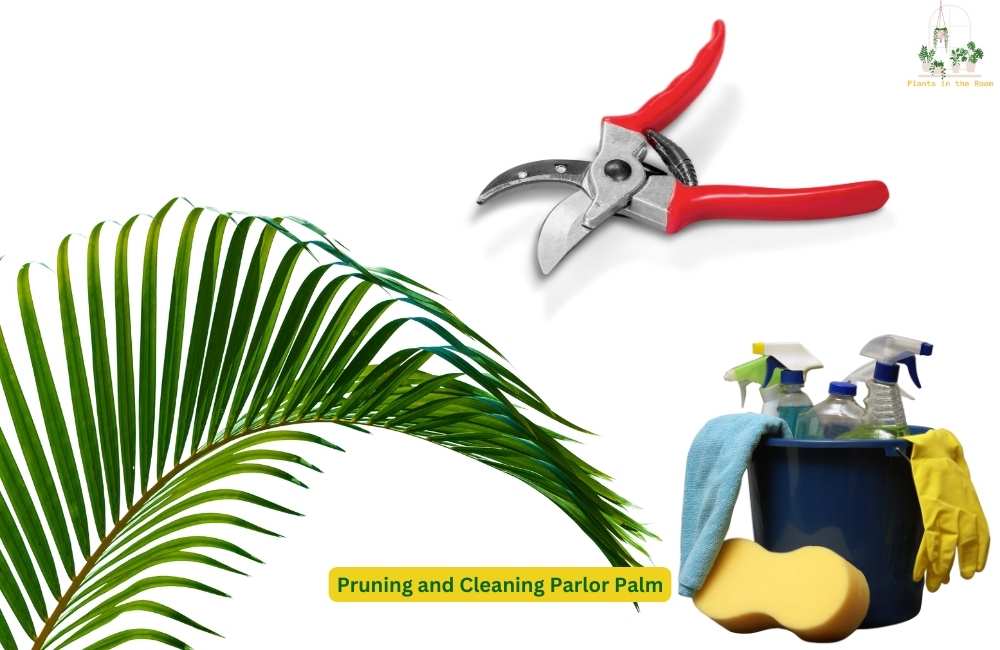
Parlor Palms are not particularly demanding when it comes to grooming. Still, occasional pruning and cleaning can help maintain their elegant appearance and ensure their leaves are free to perform photosynthesis effectively.
Pruning Tips
Pruning my Parlor Palm is more about aesthetics and the plant’s health than promoting growth. Unlike many plants, Parlor Palms don’t require regular pruning. I usually leave my plant alone unless I notice a frond that has turned yellow, brown, or damaged.
When I do prune, I sterilize my pruning shears to prevent the spread of disease and cut the unwanted frond off at the base. It’s important to remember only to remove fronds that are completely dead or damaged—trimming healthy green fronds can stress the plant.
Cleaning the Fronds
While Parlor Palms don’t collect as much dust as some plants with larger leaves, they still benefit from occasional leaf cleaning. Dust can block light, hindering the plant’s photosynthesis process.
I gently wipe the fronds with a damp cloth or give them a light shower to clean the dust. If you want to shower your Parlor Palm, let the plant drain thoroughly before placing it back in its usual spot.
These simple grooming habits can keep your Parlor Palm looking lush and vibrant, contributing to the overall aesthetics of your space.
Troubleshooting Common Problems: Understanding Parlor Palm Symptoms

Every plant lover is likely to encounter some challenges along the journey, and Parlor Palm care is no exception. Seeing signs of distress in your plant can be disheartening, but I’ve learned that these symptoms are the plant’s way of communicating its needs. In my journey, I’ve encountered a few common issues and solutions that have helped me maintain the health of my Parlor Palm.
Yellowing Leaves
Yellowing leaves in Parlor Palms can indicate a few problems, but in my experience, it’s often a sign of overwatering. Parlor Palms enjoy moist soil but don’t want to sit in water. When I notice yellowing leaves, I first check the soil’s moisture levels and the pot’s drainage. Adjusting the watering routine and ensuring the pot drains properly can quickly rectify this issue.
Brown Leaf Tips
Brown leaf tips are another common issue I’ve encountered. This symptom can indicate a few potential issues, including low humidity, over-fertilization, or tap water high in chlorine or fluoride. To address this, I started by increasing the humidity around my plant. If that didn’t work, I would consider if I had been over-zealous with my feeding schedule. I use rainwater, distilled water, or tap water left out overnight to reduce potential chemical stress if everything fails.
Slow Growth or No New Leaves
Parlor Palms are not the fastest-growing plants, but if I noticed particularly slow growth or no new leaves, I knew my plant could lack something essential. This issue could be due to inadequate light, a nutrient deficiency, or the plant becoming root-bound. I adjusted my plant’s location to ensure it was getting enough light and revised my feeding routine. If these didn’t work, I would check the roots to see if repotting was needed.
Troubleshooting plant problems can seem intimidating, but with observation and a bit of knowledge, it becomes a rewarding part of the plant care journey. Remember, patience is key; plants often take time to bounce back.
In Conclusion
In my journey with Parlor Palm care, I’ve found that these charming plants make a wonderful addition to any indoor garden with their tropical allure and relative ease of care. With the right care – appropriate light, balanced watering, and regular feeding – your Parlor Palm can flourish, bringing a touch of lush greenery into your home.
The key is understanding their needs and being responsive to their signals. Once you master these basics, caring for a Parlor Palm will become a rewarding part of your green routine.




